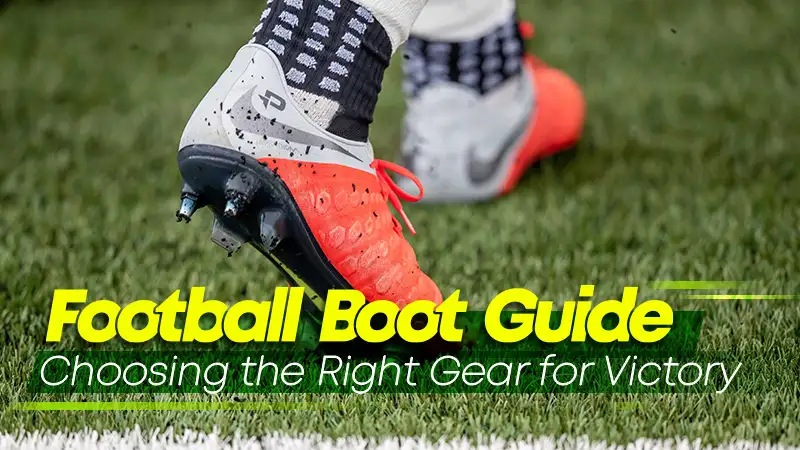Football Boot Guide: Choosing the Right Gear for Victory
- 04/30/2024
In the world of football, the right equipment can make all the difference. Among these, football boots stand out as one of the most critical pieces of gear, serving as the interface between players and the pitch.
While all soccer boots share the same purpose, they are diverse in features and stud configurations, tailored to adapt to various playing surfaces. This guide will cover essential aspects of choosing football boots and maximizing your performance on different playing surfaces.

Selecting the Right Sole for Different Field Surfaces
Field surfaces play a pivotal role in determining the type of football boots for optimal performance. Soccer boots are categorized based on field type, such as artificial turf or natural grass.
SG (Soft Ground): Crafted for wet, soft natural grass pitches, these boots boast fewer, longer metal studs for superior traction. Ideal for professional matches where pitches are watered pre-game to maintain moisture and coolness, they prevent mud clogging and minimize slipping and injuries. However, they are not suitable for use on harder surfaces, as they may increase the risk of ankle injuries.
FG (Firm Ground): FG boots, favored by professional athletes, commonly have shorter and more numerous studs than SG boots. Made of rubber or hard plastic, these studs are designed for firm, dry natural grass pitches. Their design and shape vary by brand, with common types including conical, blade, and hybrid studs, striking a balance between grip and mobility.
AG (Artificial Grass): Tailored for artificial turf surfaces, artificial grass shoes have shorter, more studs than FG models. Their conical or hollow shapes offer optimal traction and stability while preventing turf damage. Designed for enhanced balance and agility, they minimize slip-ups and accidents. Strategically placed studs ensure even weight distribution, reducing the risk of injuries like ankle sprains.
TF (Turf): Turf shoes feature densely distributed studs, almost indistinguishable in shape, designed for playing on surfaces like sand-based or water-based synthetic turf or indoor courts. The rubber sole with multiple small studs or rubber nubs in various directions provides excellent grip and traction on artificial turf, reducing the risk of injuries. However, TF studs may not be ideal for intense contact matches due to an increased risk of twisting injuries.
IC/IN (Indoor): Tailored for indoor surfaces, these boots use rubber flat soles and are not technically considered studded footwear. On wooden floors in indoor sports arenas, studded boots can lead to slipping. Instead, sole patterns enhance traction, ensuring better grip and stability.
Each sole type is optimized for specific sports surface conditions, ensuring optimal traction, comfort, and performance.
A Quick Overview of Types of Football Boot Studs
| Boot Type | Stud Type | Stud Configurations | Recommended Surface |
| SG | Metal Studs | 4 studs forefoot, 2 studs heel | Soft and wet natural grass |
| FG | Rubber Studs | Longer studs, sparse distribution | Hard natural grass |
| AG | Rubber Studs | Shorter studs, dense distribution | Artificial grass |
| TF | Turf studs | Dense stud distribution | Sand or water-based artificial grass |
| IC/IN | Flat sole | Grooved pattern, no studs | Indoor field |
Enhancing Practicality and Comfort
Beyond field adaptation, the practicality and comfort of football boots are vital considerations. Let’s break down the essential factors contributing to both speed and ball control, as well as comfort.
Speed
Streamlined designs and lightweight materials are essential for maximizing speed on the field. Soccer boots are commonly crafted from either natural leather or synthetic fibers.
• Natural leather: Kangaroo leather offers top-tier performance with its lightweight, durable, and elastic properties. However, it’s hindered by its limited availability and high cost. Cowhide, while also flexible, tends to be heavier, impacting agility.
• Synthetic fibers: Subdivided into PU synthetic leather and microfiber, PU synthetic leather is less lightweight and more affordable, whereas microfiber offers superior lightweight properties at a higher cost.
Ball control
In football, victory hinges not only on speed but also on the ability to control the ball. Some auxiliary designs of soccer shoes aim to enhance this ability.
• Concealed lace design: Reducing instability caused by lace contact with the ball.
• Friction strip technology: Increasing surface friction to improve dribbling ability.
Comfort
Comfort plays a vital role in player performance and injury prevention. It encompasses fit, ankle protection, and breathability.
• Fit: Understanding foot morphology helps in selecting the right fit for different foot types. If your first toe is the longest, avoid narrow or pointed shoes. For equal toe lengths, choose flexible shoes, ideally made of kangaroo leather. Individuals with a longer second toe can comfortably wear most slim and elongated boots.
• Ankle protection: High-top boots offer superior ankle support, particularly on artificial turf pitches with prevalent rubber granules, they effectively prevent discomfort caused by small rubber particles. Conversely, low tops offer convenience but lack adequate support.
• Breathability: Natural leather provides superior breathability compared to synthetic fibers, with Kangaroo leather being the most breathable.

Tailoring Choices to Individual Preferences
Ultimately, the choice of football boots should align with individual preferences and playing style. Each player has unique needs, and finding the right pair of boots involves considering factors such as physique, technical attributes, and playing style.
Matching boots to these specific requirements enables players to excel on the field while enjoying greater comfort and safety.
Conclusion
In wrapping up, selecting the best football boots should be based on several factors, including traction, speed, fit, comfort, and more. By understanding the diverse features and considerations involved, players can make informed decisions that enhance their overall playing experience and increase their chances of victory.



